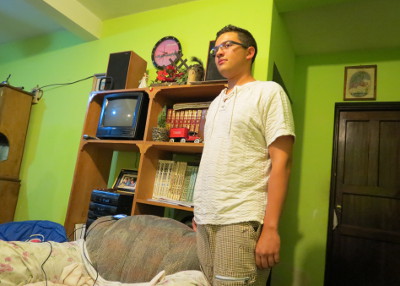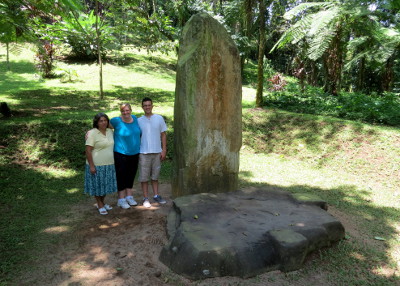Friday, August 31, 2012
Juana
Just before leaving town, we stopped to visit Hermana Juana and her daughter. They did not remember me by name, but they did remember a funny experience that we shared.
During the new year in San Bartolo, the four missionaries from my district went to Juana's house for a holiday dinner. They made giant tamales made from pig lard and packed in banana leaves. One tamal by itself is a complete meal on its own, but every time we finished one, the family would insist that we eat another. We each tried to get out of eating any more, but the family was very insistent. In the end, we had each eaten four or five tamales.
Just after midnight, we walked back to our apartment in the LDS chapel. The walk was only three or four blocks, but about half way, we all felt the tamales at the same time. You just can't eat that much pig lard in one sitting without feeling the effects. We all started running to get to the bathrooms in the church. There were only two bathrooms, but four missionaries who desperately needed to relieve themselves of some tamales. I arrived first and locked myself in the bathroom. My poor companion sat outside and pounded on the door. "Compa," he pleaded, "Hurry!"
"But I'm not done," I said.
"I don't care. Cut it off in the middle and come back later," he demanded. He was almost crying.
As I recounted the story to Hermana Juana, she just sat there and laughed. She said, "Oh, I do remember that. I think we did that on purpose." She covered her mouth with embarrassment, but also with a subtle sense of delight.
Raymunda
Years ago, Sister Raymunda welcomed us to San Bartolo with open arms. Now twenty years later, she welcomed us again as if we had never left. Her elderly mother still lives in her home. We also had the chance to meet her son Israel.
Twenty years ago, Raymunda adopted a baby girl and asked me to give her a name. She said, "I want you to give her a strong name from the Bible." I could not name her Moses, so I chose the Hebrew version of Moses' sister Miriam. For her second name, I chose Esther, who saved her people from destruction, so then her name became Miriam Esther. I had not seen her since she was a baby, but during this trip we also got to meet her as an adult.
Dakota sang.
Raymunda.
The Flakes
Brother and Sister Flake are missionaries in San Bartolo Aguascalientes. They spent most of the day with us when we visited the town. In fact, Sister Flake helped me to get in contact once again with Hermana Raymunda. They are a very sweet couple; I only wish we could have spent a little more time together.
La Danza
Our visit happened to coincide with the festival in honor of the patron saint of San Bartolo. We witnessed a short dance in the street.
Grenadilla
Grenadilla is a fruit that has an exterior that tears like cardboard, kind of like a pomegranate, but a juicy interior. The inner portion of the fruit is green and slimy. Some say it looks like a brain; Rhonda said it looked like snot. They were very hesitant to taste it, but once they did, they discovered it is very sweet.
San Bartolo
San Bartolo is at the end of a long drive through the highlands of Momostenango. In fact, the country is so high that in spite of being in the tropics, the weather is quite cool. The pine trees remind me of home.
San Bartolo was my second area. Back then, it felt like the edge of the world; like anything could happen and no one would ever know. In those days, we walked everywhere; there was hardly anyone on the roads. How things have changed. Now there is a paved highway leading right into town, connecting San Bartolo to the rest of the world.
We stopped to visit the LDS Church in San Bartolo. Back then, we lived in a small apartment in the back of the church. It turns out that the missionaries still live there, but now they have an older couple instead of young men. We got to meet Brother and Sister Flake, but more on that later.
Rhonda in front of the chapel.
Our visit just happened to coincide with the yearly festival to the patron saint of San Bartolo. These men were playing musical instruments outside the Catholic Church.
Traditional dancers in the street.
A man climbed into the Ferris wheel to fix a broken part.
Many of the dancers dress as Spaniards. The dance has something to do with re-enacting the conquest, but no one has ever explained the exact details to me.
I did a small amount of gambling when I placed my Q1 on one of these colored squares and rolled a pair of dice. If the dice had rolled my picture, I would have won double, but since it rolled something else, I lost.
These two boys got into an argument over which of them would get to shine my shoes. It was something of a novelty to me, but then I got to thinking that they make a living doing this. I settled the argument by suggesting that they each shone one shoe. They could then split the money. They agreed that this was better than one getting everything and the other getting nothing.
The streets were decorated for the festival.
The Catholic Church was also adorned for the festival.
This is the door to my old room in San Bartolo. During our visit, I told a story about the fleas that used to infest that little room. Every morning I woke up with blood spots on my clothes. Brother and Sister Flake use that room now. She was aghast by my story, especially since those fleas are still there. After twenty years, she has the same problem.
We took a picture outside the chapel.
Twenty years ago, I took a picture of my companions from the same spot.
As a young missionary, I rode the bus into San Bartolo late at night as four of us traveled together. Like I mentioned before, San Bartolo felt like the edge of the earth; it seemed like a cold and desolate place, buried deep in the mountains. When we arrived at our apartment in the church, one of the elders fumbled with the keys to the gate. Just then, an Indian man stood across the street under a street lamp and looked right at me as he started to whistle my father's song. If this had happened now, I would have been curious, but back then, those kinds of things scared me. The hair stood up on my arms and I yelled at the other missionary to hurry and open the gate.
During our recent trip, I stood under the same street lamp for a picture.
Dakota trying a grenadilla fruit.
Santa María
On Tuesday, we drove to San Bartolo Aguascalientes by way of Momostenango. As we approached San Francisco El Alto, we turned back and saw the beautiful valley of Quetzaltenango with the Santa María volcano rising in the distance.
Click on the photo to enlarge.
Noche de Hogar
Perhaps the greatest highlight of our trip to Guatemala was the family home evening we shared with the Castillo and the Vasquez families. We did things a little different than usual; we sang four hymns and then all the adults present shared their testimonies. And of course, they all insisted on singing the saddest hymns ever, like "God be with you til we meet again" and "Nearer my God to thee." By the end of the evening, everyone was in tears, but it was a very sweet meeting between old friends.
Yaneth and her granddaughter.
David's family and Raul's family.
Dakota sang "Savior Redeemer of My Soul."
Raul, Bacilia, and two of their sons.
Lluvia
Rhonda and Dakota discovered the rain of Colomba, Guatemala. As I mentioned earlier, we were all walking to the cemetery, when the rain began to fall. For us, it was something of a novelty, so we enjoyed it.
Twenty years ago, when I lived in Colomba, the rain was a source of constant misery. I remember sometimes being so wet that I would take my socks off at the end of the day, wring them out, and hang them on a line to dry. Unfortunately, the air was so humid that my clothes never got dry. The next morning, I would have to put on my wet socks to start the day.
Tuesday, August 28, 2012
Takalik Abaj
On Monday, we drove to Coatepeque to see someone I knew from the mission, but we were never able to connect. Instead, we had lunch and continued on our way to visit Takalik Abaj, an archaeological site with features of both the Maya and Olmec cultures.
Years ago, the site was named Abaj Takalik, which in the Maya Quiche language means "Rock Standing," so called for its many standing altar stones. However, the Quiche language typically places the noun after the adjective, which is different from the Spanish word order. Therefore, they reversed the words to make the name consistent with correct Mayan grammar: Takalik Abaj (Standing Rock).
Takalik Abaj also has abundant vegetation, like this cacao pod.
Hermana Castillo called this flower "Bird of Paradise."
Dakota and Rhonda in the jungle.
Dakota and I in the jungle.
In some places the vegetation completely covered the sky.
Steps of an old temple.
There is also a small zoo on site.
This crocodile never moved.
Hermana Castillo called this bird quiebrahuesos (the bone breaker).
I don't remember the name of this animal with the sad eyes, but it was Rhonda's favorite. She put her face up to the cage and started talking to the animal in a sweet, high pitch voice, "Oh, you are so cute!" She went on like this for a short while, until the animal grabbed onto the cage with both hands and started shaking and hissing. We all laughed that Rhonda's "cute" animal turned out to be quite fierce.
This altar stone faced the west and
was related to death and the underworld.
The guide explained that this small complex was a temazcal or a sweat bath, much like the sweathouses of today. The only difference is that these baths were reserved for the rulers of the city.
Perhaps the most interesting aspect of the whole tour is the fact that all of the altars are still used for Mayan ceremonies. Next to each of the ancient stone altars is a new altar that allows the Maya people make offerings of fire without damaging the old altars.

















































